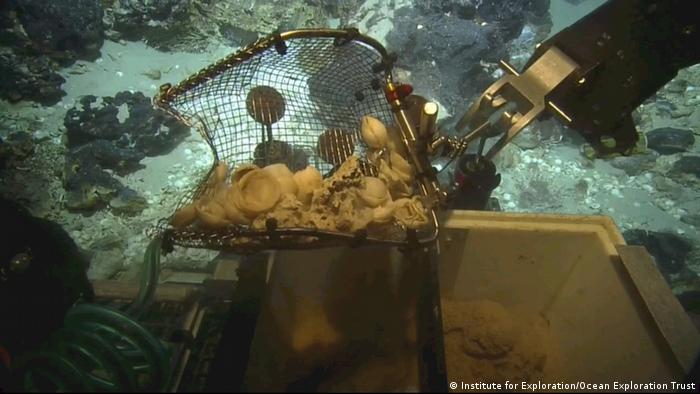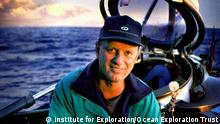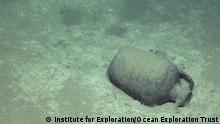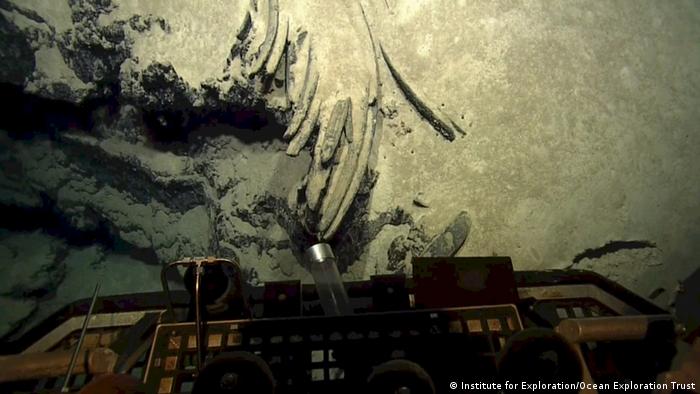
American oceanographer Dr. Robert Ballard says his latest deep
sea expedition off the coast of Cyprus has revealed an amazing array of
life forms, shipwrecks and unusual discoveries.
During most of August, Ballard's research team on board the EV Nautilus
have concentrated on the unique geological makeup of the Eratosthenes
Seamount, one of the largest features on the eastern Mediterranean
seafloor.
 Ballard shot to fame after 'discovering' the Titanic in 1985
Ballard shot to fame after 'discovering' the Titanic in 1985
“We have found a lot of fascinating things," Ballard told DW, on
board the Nautilus. "You have to realize that when you go where no one
has gone before on planet earth, you are not really sure what you're
going to find.”
“We've been making some real biological discoveries, and we've also been mapping two Ottoman war galleys which sank about 3,000 feet beneath where we are right now."
The remains of the Ottoman war galley were found along with a flintlock pistol and what appeared to be black rum bottles littering the sea floor.
Surprisingly, the metal pistol seemed to be remarkably well-preserved, but most of the wood from the ship has deteriorated having been eaten away by marine organisms.
Uncharted waters
Ballard found global fame in 1985 after discovering the Titanic some three miles below the surface of the Atlantic. This discovery gave the world its first glance at the ghostly ship that sank in April 1912 after hitting an iceberg.
His sensational discovery launched a whole new Titanic movement – spawning books, films and documentaries. It also gave Ballard the opportunity to be able to indulge in his passion of going “where no man has gone before."
 Ballard and his team have found a range of artefacts
Ballard and his team have found a range of artefacts
His crew for the Cyprus expedition includes researchers, geologists
and the renowned NASA astronaut, Cady Coleman, who is working as their
navigator. She says that the earth's oceans, much like deep space,
remain a largely unexplored frontier.
“There are a lot of similarities in a general sense, but sometimes things happen really quickly - we suddenly see something underwater, we want to record its position immediately ... And it's up to me to coordinate those things and that's kind of similar to being up in space.”
Rare discoveries
For those onshore, the expedition brought a once-in-a-lifetime adventure, as cameras beamed live, high definition pictures from the bottom of the Mediterranean sea to the internet.
Katy Croff Bell, chief scientist of the Nautilus Exploration Programme, says that many viewers to the web stream were able to delve into the oceans' secrets. Viewers witnessed a huge shark crossing the ship's path with other highlights - including live pictures of mating squid and fossilized whale bones.
“The most unexpected discovery," says Bell "was the fossilized rib cage of a large mammal, possibly a whale. We immediately contacted marine mammal specialists who are following up on the discovery to determine what and how old it is. We have also observed mating squid possibly for the first time ever for this species, and increased the known depth range of a particular species of fish.”
 Biological discoveries have been made as well - above we see what's believed to be fossilized whale bones
Biological discoveries have been made as well - above we see what's believed to be fossilized whale bones
Technology applied
Bell says one of the most important results of their exploration was the use of a so-called tele-presence, which means experts were on-call day-and-night to assist the team onboard when discoveries were made.
“In every case, we were able to contact specialists who provided their expertise on how to proceed with studying the amazing discoveries that we have made in Cypriot waters,” she says.
For Robert Ballard, the most fascinating aspect of the expedition was the in-depth probe of the Eratosthenes Seamount, which measures 120 km long and 80 km wide. Its peak lies at the depth of 690 meters and it rises 2000 meters above the surrounding seafloor.
“It's large, and it's situated between Cyprus and Egypt, so we're in an area traversed by a lot of ancient mariners. And during our time here we've been able to document a whole range of artifacts that have fallen to the ocean floor.”
 Ballard shot to fame after 'discovering' the Titanic in 1985
Ballard shot to fame after 'discovering' the Titanic in 1985“We've been making some real biological discoveries, and we've also been mapping two Ottoman war galleys which sank about 3,000 feet beneath where we are right now."
The remains of the Ottoman war galley were found along with a flintlock pistol and what appeared to be black rum bottles littering the sea floor.
Surprisingly, the metal pistol seemed to be remarkably well-preserved, but most of the wood from the ship has deteriorated having been eaten away by marine organisms.
Uncharted waters
Ballard found global fame in 1985 after discovering the Titanic some three miles below the surface of the Atlantic. This discovery gave the world its first glance at the ghostly ship that sank in April 1912 after hitting an iceberg.
His sensational discovery launched a whole new Titanic movement – spawning books, films and documentaries. It also gave Ballard the opportunity to be able to indulge in his passion of going “where no man has gone before."
 Ballard and his team have found a range of artefacts
Ballard and his team have found a range of artefacts “There are a lot of similarities in a general sense, but sometimes things happen really quickly - we suddenly see something underwater, we want to record its position immediately ... And it's up to me to coordinate those things and that's kind of similar to being up in space.”
Rare discoveries
For those onshore, the expedition brought a once-in-a-lifetime adventure, as cameras beamed live, high definition pictures from the bottom of the Mediterranean sea to the internet.
Katy Croff Bell, chief scientist of the Nautilus Exploration Programme, says that many viewers to the web stream were able to delve into the oceans' secrets. Viewers witnessed a huge shark crossing the ship's path with other highlights - including live pictures of mating squid and fossilized whale bones.
“The most unexpected discovery," says Bell "was the fossilized rib cage of a large mammal, possibly a whale. We immediately contacted marine mammal specialists who are following up on the discovery to determine what and how old it is. We have also observed mating squid possibly for the first time ever for this species, and increased the known depth range of a particular species of fish.”
 Biological discoveries have been made as well - above we see what's believed to be fossilized whale bones
Biological discoveries have been made as well - above we see what's believed to be fossilized whale bonesBell says one of the most important results of their exploration was the use of a so-called tele-presence, which means experts were on-call day-and-night to assist the team onboard when discoveries were made.
“In every case, we were able to contact specialists who provided their expertise on how to proceed with studying the amazing discoveries that we have made in Cypriot waters,” she says.
For Robert Ballard, the most fascinating aspect of the expedition was the in-depth probe of the Eratosthenes Seamount, which measures 120 km long and 80 km wide. Its peak lies at the depth of 690 meters and it rises 2000 meters above the surrounding seafloor.
“It's large, and it's situated between Cyprus and Egypt, so we're in an area traversed by a lot of ancient mariners. And during our time here we've been able to document a whole range of artifacts that have fallen to the ocean floor.”
沒有留言:
張貼留言